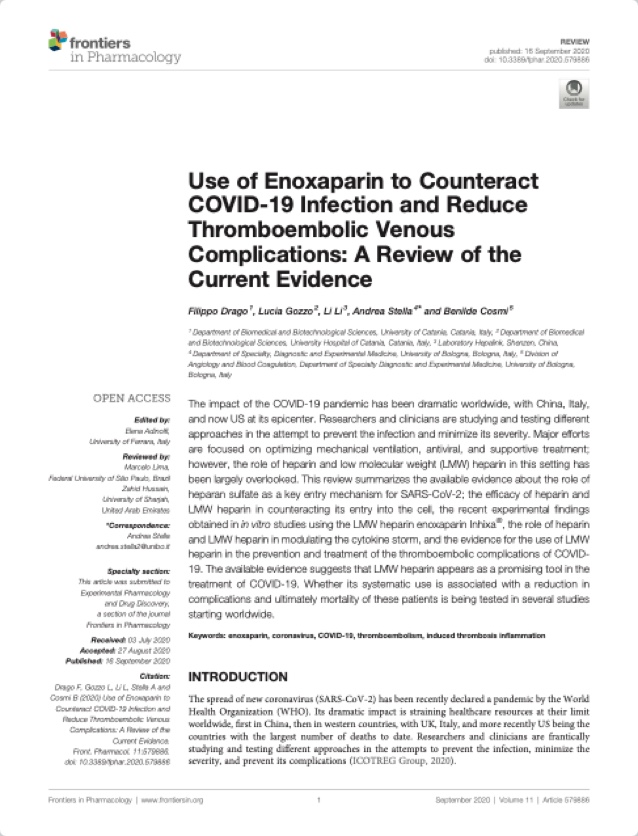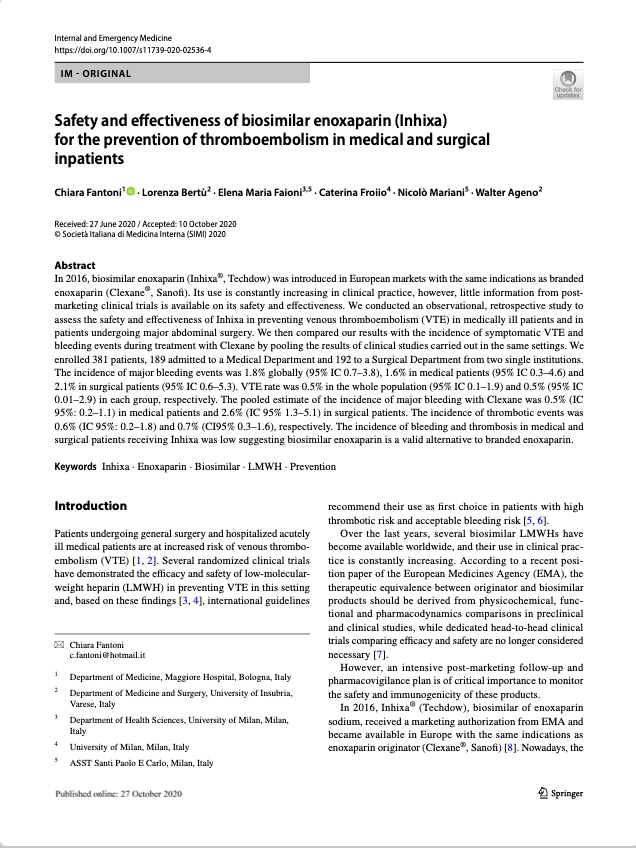USE OF ENOXAPARIN TO COUNTERACT COVID-19 INFECTION AND REDUCE THROMBOEMBOLIC VENOUS COMPLICATIONS: A REVIEW OF THE CURRENT EVIDENCE
Filippo Drago, Lucia Gozzo, Li Li, Andrea Stella and Benilde Cosmi
The impact of the COVID-19 pandemic has been dramatic worldwide, with China, Italy, and now US at its epicenter. Researchers and clinicians are studying and testing different approaches in the attempt to prevent the infection and minimize its severity. Major efforts are focused on optimizing mechanical ventilation, antiviral, and supportive treatment; however, the role of heparin and low molecular weight (LMW) heparin in this setting has been largely overlooked. This review summarizes the available evidence about the role of heparan sulfate as a key entry mechanism for SARS-CoV-2; the efficacy of heparin and LMW heparin in counteracting its entry into the cell, the recent experimental findings obtained in in vitro studies using the LMW heparin enoxaparin Inhixa®, the role of heparin and LMW heparin in modulating the cytokine storm, and the evidence for the use of LMW heparin in the prevention and treatment of the thromboembolic complications of COVID- 19. The available evidence suggests that LMW heparin appears as a promising tool in the treatment of COVID-19. Whether its systematic use is associated with a reduction in complications and ultimately mortality of these patients is being tested in several studies starting worldwide.
SAFETY AND EFFECTIVENESS OF BIOSIMILAR ENOXAPARIN (INHIXA) FOR THE PREVENTION OF THROMBOEMBOLISM IN MEDICAL AND SURGICAL INPATIENTS
Chiara Fantoni, Lorenza Bertù, Elena Maria Faioni, Caterina Froiio, Nicolò Mariani and Walter Ageno
In 2016, biosimilar enoxaparin (Inhixa®, Techdow) was introduced in European markets with the same indications as branded enoxaparin (Clexane®, Sanofi). Its use is constantly increasing in clinical practice, however, little information from post- marketing clinical trials is available on its safety and effectiveness. We conducted an observational, retrospective study to assess the safety and effectiveness of Inhixa in preventing venous thromboembolism (VTE) in medically ill patients and in patients undergoing major abdominal surgery. We then compared our results with the incidence of symptomatic VTE and bleeding events during treatment with Clexane by pooling the results of clinical studies carried out in the same settings. We enrolled 381 patients, 189 admitted to a Medical Department and 192 to a Surgical Department from two single institutions. The incidence of major bleeding events was 1.8% globally (95% IC 0.7–3.8), 1.6% in medical patients (95% IC 0.3–4.6) and 2.1% in surgical patients (95% IC 0.6–5.3). VTE rate was 0.5% in the whole population (95% IC 0.1–1.9) and 0.5% (95% IC 0.01–2.9) in each group, respectively. The pooled estimate of the incidence of major bleeding with Clexane was 0.5% (IC 95%: 0.2–1.1) in medical patients and 2.6% (IC 95% 1.3–5.1) in surgical patients. The incidence of thrombotic events was 0.6% (IC 95%: 0.2–1.8) and 0.7% (CI95% 0.3–1.6), respectively. The incidence of bleeding and thrombosis in medical and surgical patients receiving Inhixa was low suggesting biosimilar enoxaparin is a valid alternative to branded enoxaparin.


